The ASUS ROG Strix G15 (G513QY) Review: Embracing AMD's Advantage
by Brett Howse on May 31, 2021 11:00 PM ESTDisplay Analysis
ASUS offers two display options with the Strix G513QY, with a 300 Hz 1920x1080 option targeting the sRGB gamut, and a 165 Hz 2560x1440 panel with P3 gamut coverage. Both displays are IPS variants, and both offer 3 ms response times. AMD shipped us the 1920x1080 unit, which will be tested here.
AMD offers FreeSync Premium, meaning variable refresh rate is supported, preventing screen tearing and stuttering, and much like NVIDIA’s Advanced Optimus, the discrete GPU can be turned on and off without requiring a system reboot, while still allowing for variable refresh rate, so that is a major win.
 Matte finish leaves a haze-like appearance on the pixels
Matte finish leaves a haze-like appearance on the pixels
The 1920x1080 panel targets the sRGB gamut, which is the normal color gamut for a Windows PC. The higher resolution offering goes for the much wider gamut of P3-D65, meaning it can achieve deeper colors, however with the lack of a system-wide color management system in Windows 10 generally means that is more of a detriment than an advantage.
The display offers a matte finish, with no touch options, which is pretty much par for the course in the gaming notebook space. Touch controls are just not required, since most people will use a keyboard and mouse. The matte coating does leave a hazy finish on the display, which means the images are not quite as crisp as they would be on a display with a clear coating, but it can help with usability to have a matte coating in a room with light glare.
To test the display capabilities and accuracy, we use Portrait Display’s Calman software with a custom workflow. The X-Rite i1 Display Pro colorimeter is used for brightness and contrast readings, and the X-Rite i1Pro 2 spectrophotometer is used for color accuracy tests.
Brightness and Contrast
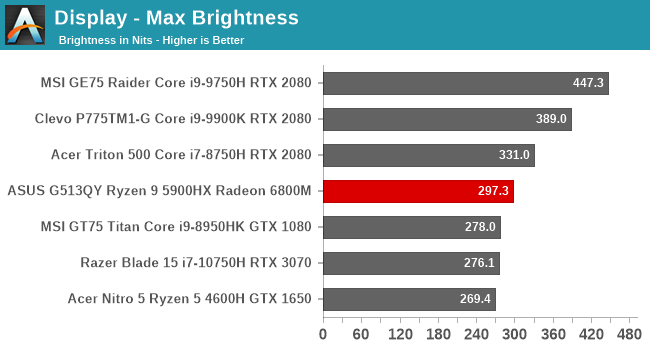
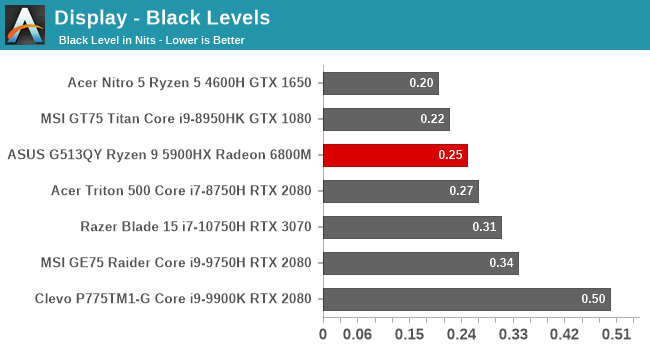
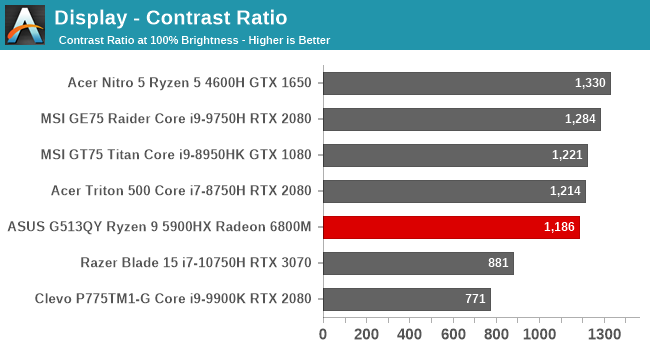
ASUS advertises the display as a 300-nit panel, and we measured 297.3 nits, which is pretty much right on the money. The contrast ratio is good, but not great, at 1186:1, measured at maximum brightness. Considering high-refresh rate panels used to be the domain of TN only, it is great to see the industry has been able to drive IPS panels such as this, relegating the TN to mostly a footnote in history in the PC space. For those that are curious, the display will go down to about 13 nits brightness at its lowest setting.
Grayscale
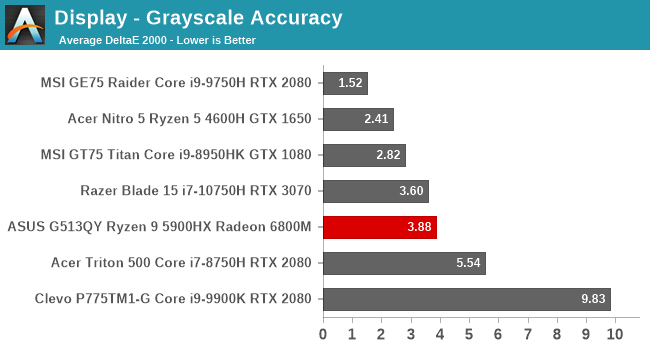
The panel in the review unit most certainly skews towards blue, although the overall error level is reasonable. A few years ago, this same device almost certainly would have shipped with a TN display with error levels around 10-12, so only seeing 3.8 average error is reasonable. ASUS does not hardware calibrate its panels, unlike say MSI, who offers a TrueColor application to choose and modify the color settings. Gamma is almost perfect on this display though, despite the white point being incorrect.
Gamut
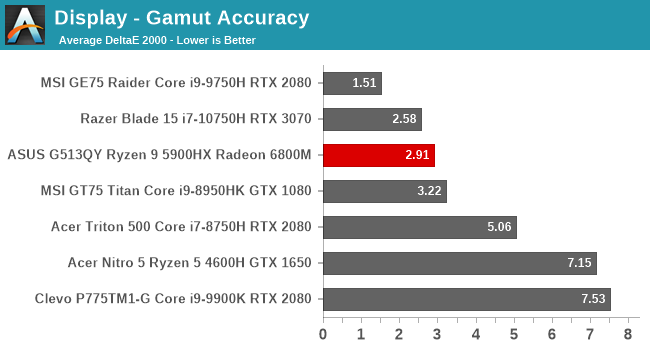
The gamut test checks the primary and secondary colors at the 100% level, and the ASUS display does indeed hit the sRGB gamut almost perfectly.
Saturation
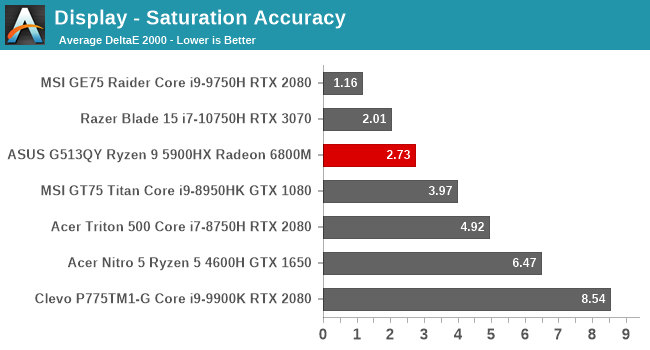
Unlike the gamut test, the saturation sweeps test all of the primary and secondary colors from 0% to 100% level at 4-bit increments. Other than Cyan, all of the colors are reasonably accurate considering this is not a calibrated display.
Gretag Macbeth
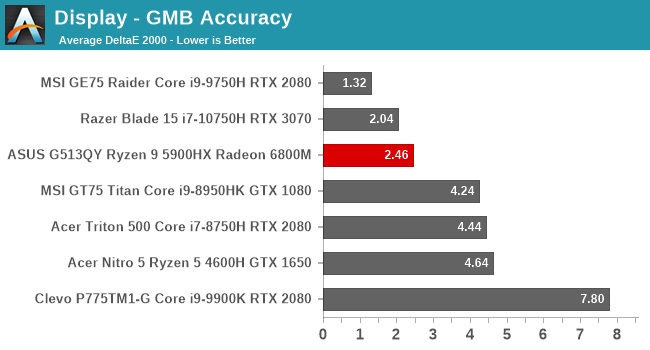
The final test targets colors outside of the primary and secondary color axis, including the important skin tones. Although some of the colors, especially the grays, exceed the 3.0 error level that would be considered inaccurate, most of the colors do fall under 3.0, making the overall average 2.5, which is very reasonable.
Colorchecker
Finally, the colorchecker is a visual representation of the testing done, with the targeted color on the bottom, and the actual color the display produced on the top. This is a relative result, as any errors in your own display will skew this result, but really, the ASUS panel is quite accurate with the exception of the extra blue levels in the grays.
Display conclusion
Considering this is not a calibrated display, it achieved quite good color accuracy, and really the only miss was the grayscale results which would be able to be adjusted using an ICC profile if a user wanted to make one. It is unfortunate that ASUS does not offer this built into hardware though, as ICC profiles generally do not work very well with games.
The other side of the coin is that this is a 300 Hz display, at just 1920x1080. Even with the massive Radeon RX 6800M, pretty much no game is going to hit anywhere near 300 FPS since the GPU is always bound by the CPU, making most of the refresh waste unnecessary. The 165 Hz QHD panel option would be the better choice, although it does target the P3 color gamut, which brings its own issues to the table on Windows PCs.















146 Comments
View All Comments
WaltC - Friday, June 4, 2021 - link
I'm almost positive I read the laptop offers an HDMI and DP (USB-C) output, for external monitors/TVs one would presume--too bad the reviewer here forgot to test a 1440P external monitor--which is likely considering the target market for this monitor. The reviewer kept talking about the absence of a web cam and a limit of 1080P (which doesn't exist) as if either was an insurmountable design flaw--oh, gee, I guess thinking just a little bit out of the box is difficult for people these days. He could have tested with an external monitor at > 1080P--and if he looked hard enough he might even have found one with a built-in web cam. Do tell. But that would have prevented the negative observations, I guess--so we can't have that, eh? BTW, 1080P is nice indeed when you are running on batteries--but I guess that was a bit too obvious to get his attention. Many, many people with laptops plug them into the wall at home and attach monitors/TVs/ whatever else they might want. No sense in writing a review which pretends otherwise.bejito81 - Tuesday, June 1, 2021 - link
why is this not compared with a RTX G15 (3070 or 3080 (the one matching the price the closet)) ?Ryan Smith - Tuesday, June 1, 2021 - link
AMD only sampled the AMD system. They did not sample the NVIDIA systems.Spunjji - Monday, June 7, 2021 - link
It matches a 3070 most closely in pricing, performance sits in the range of high-TDP 3070 models and low-to-medium-TDP 3080 models. Apparently it's held back a little by RAM that has slow timings - with that resolved, it's right up there with the 3080.yeeeeman - Tuesday, June 1, 2021 - link
Nice review, but I would have liked to see a bit more details on the GPU side of things, that is some 4k comparisons with rtx 3080, since that is the target competitor.I look forward to see how the 6600m fares. If that is similar or better than 3060, I could give it a shot.
Alistair - Tuesday, June 1, 2021 - link
actually the AMD laptop is cheaper than the 3070 version, it beats all in performance per dollarET - Tuesday, June 1, 2021 - link
Nice to see AMD back in the game. For the keyboard, I have one of these ASUS laptops (with a 3080) for work, and the position of the F keys really annoys me. As a programmer I use them quite a bit, and because they're shifted by 1 for the first four (F1 is above 2, F2 above 3, etc.) and half for the next four, I keep hitting the wrong one.Anyway, I'm really looking forward to seeing what the 6600M brings to the table, and if it could provide reasonable gaming performance on battery with a bit of battery life. A smaller gaming laptop that's still reasonably capable would be very nice.
ads295 - Tuesday, June 1, 2021 - link
I love this thing to bits.I wish there was a way to control the charge rate though, since pushing that crazy amount of power through the battery cannot be good for the long term. I guess you can limit the charge rate by using USB-PD but 100W means you can only slow down the discharge of the battery rather than actually charge it...
Amazing product. ASUS' work on the cooling system is commendable too. Up till now I've seen that they do not compromise on size if they feel it will affect the cooling performance. Now they've delivered cooling performance even after downsizing.
As an aside, my sisters' ASUS FX553VD suffered two major hardware issues during her ownership for which the authorised service outlet asked for INR50k+ to fix. I luckily found a guy who does low level repair and we managed to avoid buying a new laptop. Hopefully that was a solitary incident...
supdawgwtfd - Tuesday, June 1, 2021 - link
Get a 65w charger.No more worries about "to faster charging"..
You know that technology improves over time right?
It might be strange but things get better over time...
What used to be "oh my this is really bad" is now "it's fine".
ads295 - Tuesday, June 1, 2021 - link
Using a 65W charger on a system that draws over 230W at the wall?